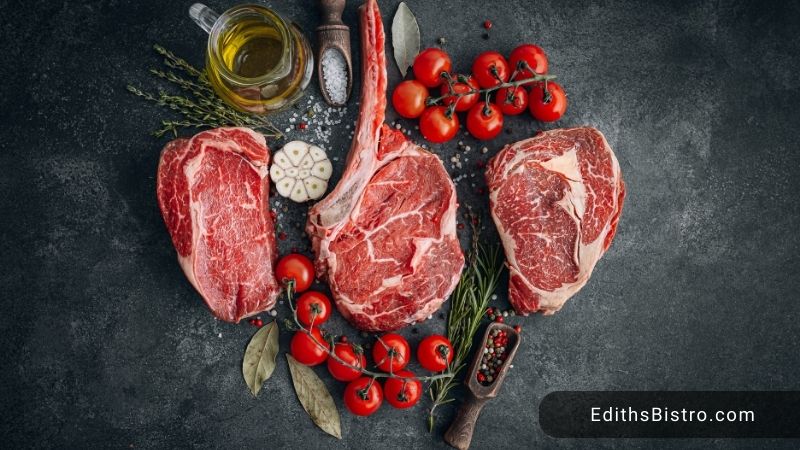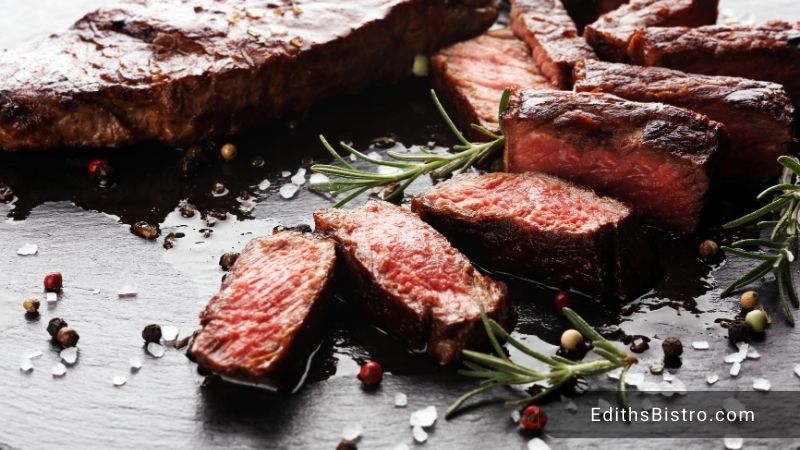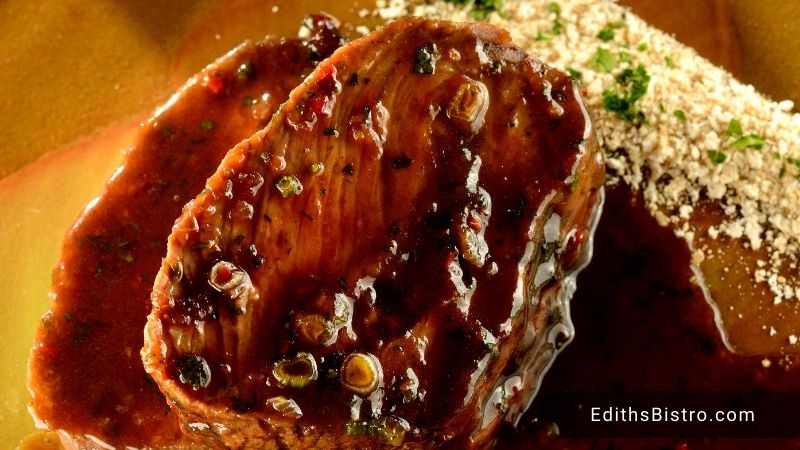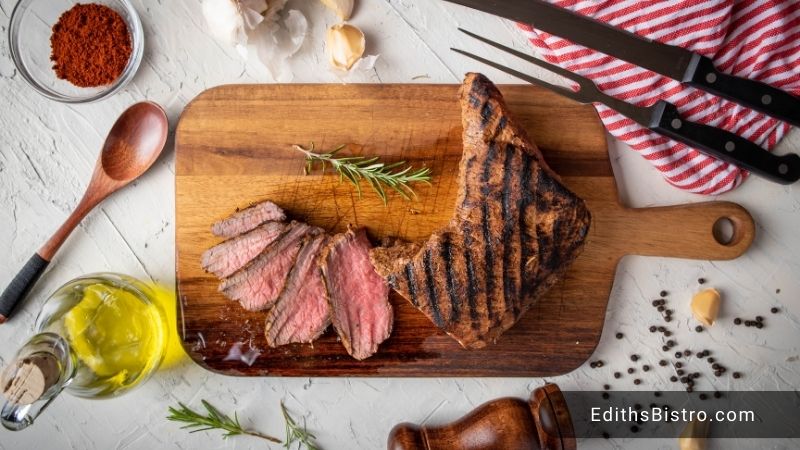Welcome to our mouthwatering deep dive into the world of steak! Whether you’re a seasoned steak-lover or a newbie eager to explore, the steak cuts explained will help unravel the mystery of these beef cuts.
From the indulgent Ribeye to the humble Shank, we’ll guide you through each cut’s unique characteristics, cooking tips, and flavor profiles. Prepare for a culinary journey that will tantalize your taste buds!
Steak Cuts Explained
A steak cut is a robust slice of meat, typically carved perpendicular to the muscle fibers, creating a thickness that’s satisfying to the touch and the taste buds.

Sometimes, it even comes with a bone, like a natural piece of jewelry. The best equipment to cook great steak in our steak cuts explained is the grill. Steaks are traditionally prepared by grilling or pan-frying, resulting in a tantalizing sear on the outside and succulent tenderness within.
What Is A Steak?
In its most basic form, a steak is a cut of beef. It’s cut perpendicular to the muscle fibers, often from the fleshy part of a beef carcass. Steaks can be bone-in or boneless and are revered for their tenderness, juiciness, and rich flavor.
What Part Of The Cow Does Steak Come From?
Take a look at the above picture. The steaks hail from three prime areas:
- Rib: This area gives us some of the most tender and flavorful steaks—like the ribeye and the showstopping tomahawk steak.
- Short Loin: Nestled behind the rib area and before the sirloin, this is where the tenderloin resides, giving us the illustrious filet mignon and the New York strip steak.
- Sirloin: Situated between the short loin and the round, the sirloin is home to the T-bone, porterhouse, and the namesake sirloin steak.
Meat Cuts Meaning
It simply means how the butcher prepares the meat for you to cook and eat easily. Different cuts will serve different purposes. Slow cook, quick cook, and more.
Meat cuts can refer to all types of meat: chicken, beef, pork, lamb, and more.
Guide To All Steak and Beef Cuts
That being said, you might see a lot of steak names being thrown around. Let’s learn all about those meat cuts here in this steak cuts explained version.
Filet Mignon
A cut from the end of the tenderloin, the filet mignon is delicate, tender, and lean – a truly popular steak. It’s a high-end choice for a reason – it’s like the silk of the steak world.
Rib Eye
Also known as a cowboy steak, the ribeye steak is a flavorful cut with a rich marbling of fat, which translates into more flavor and juiciness.
Sometimes, a ribeye steak can be considered a Delmonico steak, but not all Delmonico steaks are necessarily ribeyes. Thus, it’s essential to distinguish between ribeye and Delmonico steak.
New York Strip
This boneless steak from the short loin offers a satisfying balance of tenderness and rich flavor. It’s the denim jeans of steaks — comfortable, versatile, and always in style.
Porterhouse
This steak is the whole package, including the tenderloin and the New York strip. In simple steak cuts explained language, it’s like getting two steaks in one! No wonder why it’s been name the king of steak.
Hanger
This cut, also known as the butcher’s steak, is a flavorful and tender piece from the cow’s diaphragm. It’s a little less known but definitely worth your attention.
Flank
The flank steak is lean and flavorful, with a distinct grain that looks like long threads. It’s best cooked quickly over high heat and sliced against the grain.
Flank steak is also known as bavette steak in some regions. Even though these types of steak come from a similar part of a cow, they are not 100% the same. Bavette steak is more tender than flank steak.
T-Bone
The T-bone steak is similar to the Porterhouse, boasting both a tenderloin and a New York strip, but in smaller portions. It’s a steak lover’s dream with a built-in handle!
Shank
The shank is a tougher primal cut from the cow’s leg, best suited for slow cooking methods like braising. It’s a humble cut, but it can be extraordinary given time.
Skirt
The skirt steak is a long, flat cut from the cow’s diaphragm, similar to the flank. It’s not the most tender cut, but it’s packed with flavor.
Rump
Coming from the rear part of the cow, the rump steak is well-marbled and has a thick strip of fat, making it juicy and flavorful. It’s a cut that’s all about balance.
Tomahawk Steak
This is often taken off the steak cuts explained edition. A tomahawk steak is a large ribeye with a long bone resembling an axe. This cut is about making a statement, and it doesn’t skimp on flavor or tenderness. If you want to try, it’s important to know how much is Tomahawk steak.
Rump Vs Sirloin Vs Ribeye

Imagine stepping into a boxing ring where the contenders aren’t fighters but steaks. We have the Rump in one corner, a robust, well-marbled with fat content cut from the cow’s rear. Its thick strip of fat makes it a juicy contender, delivering a balanced flavor that’s like a well-rehearsed symphony in your mouth.
In the next corner, the Sirloin the tender steak stands tall. Cut from between the short loin and the round, it’s a versatile champion. Its flavor is a satisfying blend of tenderness and beefy goodness, like a comfortable, well-worn leather chair that always feels right.
And finally, in the third corner, the Ribeye takes its stand. Richly marbled and intensely flavorful, the Ribeye is like the star of the show, delivering a bold and unforgettable performance.
Each cut holds its own unique appeal, and picking a favorite might just come down to your personal palate’s preference. So, are you team Rump, Sirloin, or Ribeye? The choice is deliciously yours!
Cuts Of Steak Ranked – Best Cut Of Steak In The World
Ranking steak cuts is difficult in a steak cuts explained article — it’s like picking a favorite child. But based on tenderness, flavor, and overall quality, filet mignon and ribeye often top the list. However, what’s considered the “best” can vary greatly depending on personal preferences and the specific cooking method used.
Steak Cuts Essential – Best To Worst Types Of Steak To Cook
Starting on a high note, Filet Mignon is the star performer – tender, lean, and luxurious. The Ribeye, a crowd favorite, follows with its rich marbling delivering juicy flavor. The New York Strip is your reliable friend, offering a balance of tenderness and taste.
On the more adventurous side, there’s the Hanger steak, a butcher’s secret known for its deep flavor. The Flank steak, though lean and a bit tough, rewards with its robust taste.

Towards the end of the rankings of any steak cuts explained post, you’ll find the tougher cuts. The Round steak, though lean, can be a bit tough, requiring slow, careful cooking. The Shank, from the leg portion, is tough and best suited for slow-cooked dishes.
Remember, the best steak is not always the most expensive or tender—it’s the one you cook with love and that best suits your taste buds.
Tips For Cooking The Best Steak
Choosing the right steak is the first step to a memorable meal. Look for a cut with good marbling (flecks of fat within the meat), such as a Ribeye or New York Strip. The fat contributes to flavor and juiciness.
When it comes to seasoning, less is more. A generous sprinkle of coarse salt and freshly ground black pepper just before cooking is often enough to enhance the beef’s natural flavors.
The ideal internal temperature for steak depends on your preference. For medium-rare, aim for 130-135°F. For well done, aim for 145. Use an instant-read thermometer for accuracy.
Finally, let your steak rest for about 5-10 minutes after cooking. This redistributes the juices, ensuring a moist and flavorful steak. With these tips, you’re well on your way to cooking the perfect steak.
Tri-Tip Steak Recipe
As a bonus, let’s introduce you to a lesser-known cut in this steak cuts explained edition—the tri-tip steak. It’s a small, triangular cut from the sirloin and is incredibly flavorful.
We got a lot of comments on doing a recipe for this cut. So here it is. Let us know if you want other recipes!

Ingredients
- 1 tri-tip steak approximately 2-3 lbs
- 2 tablespoons of olive oil
- Salt and black pepper to taste
- 2 cloves of garlic minced
- 1 teaspoon of smoked paprika
- 1 teaspoon of dried rosemary
Instructions
- Preheat your grill to high heat.
- While waiting for the grill to heat up, rub the tri-tip steak with olive oil on all sides.
- In a small bowl, mix together the salt, pepper, minced garlic, smoked paprika, and dried rosemary. Sprinkle this seasoning mix liberally over the steak, ensuring all sides are well-coated.
- Once the grill is hot, place the steak on it and sear each side for about 5 minutes, creating a beautiful, flavorful crust.
- After searing, reduce the heat to medium, and continue grilling the steak for about 20 minutes, or until your desired level of doneness is reached.
- Once done, remove the steak from the grill and let it rest for about 10 minutes before slicing against the grain to serve. This helps the steak to retain its juices and stay moist.
FAQs
What Are The Best Cuts Of Steak In Order?
The best cuts of steak, in order of most preferred by steak cuts explained, are typically Filet Mignon, Ribeye, New York Strip, T-Bone, Porterhouse, and Sirloin.
What Is Better Sirloin Or Ribeye?
The choice between Sirloin and Ribeye often comes down to personal preference, but Ribeye is usually considered superior due to its rich marbling and robust flavor.
Which Is Fattier Sirloin Or Rump?
Comparatively, Sirloin is leaner than Rump among all steak cuts explained rendition, which has a higher fat content leading to a more flavorful, albeit tougher, steak.
References
- How to Understand Cuts of Beef: https://www.wikihow.com/Understand-Cuts-of-Beef
- Beef Up Your Knowledge: https://www.usda.gov/media/blog/2014/05/15/beef-your-knowledge-meat-marbling-101






![What To Pair With Quiche? 25+ Best Dishes [With Pictures]](https://www.edithsbistro.com/wp-content/uploads/2024/04/what-to-pair-with-quiche-160x90.jpg)
